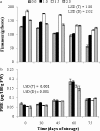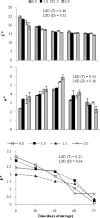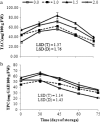Preharvest salicylic acid treatments to improve quality and postharvest life of table grapes (Vitis vinifera L.) cv. Flame Seedless
- PMID: 26028743
- PMCID: PMC4444924
- DOI: 10.1007/s13197-014-1422-7
Preharvest salicylic acid treatments to improve quality and postharvest life of table grapes (Vitis vinifera L.) cv. Flame Seedless
Abstract
Significance of preharvest salicylic acid (SA) treatments on maturity, quality and postharvest life of grape cv. Flame Seedless were studied during two years. The experiment was performed on 12-year old own rooted, grapevines planted at 3 m × 3 m spacing trained on overhead system. Vines were treated with aqueous solutions of SA (0.0, 1.0, 1.5 and 2.0 mM) at pea stage and at veraison. After harvesting, clusters were divided into two lots in which one was subjected to initial quality evaluation, while the other was stored in cold room (3-4 °C, 90-95 % RH) for evaluation of postharvest quality. SA at the dose of 1.5 and 2.0 mM hastened berry maturity by 3 to 5 days, produced less compact bunches alongside larger berries in contrast to control and the lowest dose. The same doses effectively maintained peel colour, higher firmness, lower pectin methyl esterase activity and electrolyte leakage alongside suppressing degradation of TSS and TA during cold storage. These two doses also exhibited higher efficacy on maintaining anthocyanins, phenols and organoleptic properties while reducing weight loss, rachis browning and decay incidence. Correlation analysis demonstrated that many quality parameters are interdependent. In conclusion, preharvest spray of 1.5 mM SA proved to be an effective means of improving quality and extending postharvest life of grape cv. Flame Seedless.
Keywords: Quality; Salicylic acid; Shelf life; Table grapes; Vitis vinifera L.
Figures




References
-
- Amerine MA, Pangborn RM, Roessler EB (1965) Principles of sensory evaluation of food. In: Food science and technology monographs, Academic Press, New York, p 338–339
-
- Anon (2010) Package of practices for cultivation of fruits. Punjab Agricultural University, Ludhiana, Punjab, India, p 63–74
-
- AOAC (2005) Official method of analysis of AOAC International. 18th edn, Suite 500 481, North frederick avenue, Gaithersburg, Maryland 20877–2417. USA
-
- Babalar M, Asghari M, Talaei A, Khosroshahi A. Effect of pre- and postharvest salicylic acid treatment on ethylene production, fungal decay and overall quality of selva strawberry fruit. Food Chem. 2007;105:449–453. doi: 10.1016/j.foodchem.2007.03.021. - DOI
-
- Balic I, Moreno A, Sanhueza D, Huerta C, Orellana A, Defillippi BG, Campos-Vagas R. Molecular and physiological study of postharvest rachis browning of table grape cv. Red globe. Postharvest Biol Tec. 2012;72:47–56. doi: 10.1016/j.postharvbio.2012.05.005. - DOI
LinkOut - more resources
Full Text Sources
Other Literature Sources
